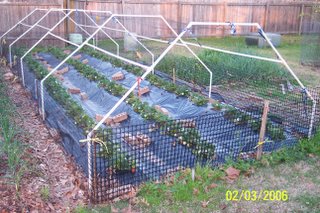Growing Strawberries
 One of the nice things about living down south in Zone 9 is the ability to grow something year round. There are an abundance of garden variety plants that can withstand our mild winters. Strawberries are on this list... And probably at the top when it comes to popularity. And therein lies the problem. EVERYONE like strawberries - including animals and insects.
One of the nice things about living down south in Zone 9 is the ability to grow something year round. There are an abundance of garden variety plants that can withstand our mild winters. Strawberries are on this list... And probably at the top when it comes to popularity. And therein lies the problem. EVERYONE like strawberries - including animals and insects.Strawberries are usually planted October through November in South Louisiana by the backyard gardener and sometimes a bit earlier for the commercial growers. In a normal year the backyard garden berries begin to ripen in late February to mid March. However, this year is not a normal year. This year the backyard strawberries ripened in January. The reason for the early production is undoubtedly the mild winter we are having. If this weather continues look for bumper crops this year - unless of course Mother Nature dishes out one of those late winter hard freezes.
This year the "animal" strawberry predators are the first to find the goodies. Unlike insects, these guys mean serious business. Several berries can be stolen or damaged in short order. The main predators are birds, raccoons and opossums. The first red berry in my backyard garden this year was harvested by bird, most likely a Mocking Bird. Normally I'm ready, but this year I was a bit late in setting up my animal defense system.
 The animal defense system consists of a plastic fence bordering the strawberry bed, a PVC frame with bird netting to cover, and when serious measures are necessary an electric fence.
The animal defense system consists of a plastic fence bordering the strawberry bed, a PVC frame with bird netting to cover, and when serious measures are necessary an electric fence.Following are a list of component materials used in the pictured design:
24 inch wide plastic fence (3 - 25 Ft lengths in the above design)
1/2 inch rebar posts 40 inch lengths for corners, 32 inch lengths for mid sections
short strips of cloth or ribbon to hold the plastic fence to the refer
3/8 inch rebar in 20 inch lengths for holding the PVC bird frame (10 pieces)
1/2 inch schedule 40 PVC pipe in a variety of lengths
1/2 inch PVC pipe fittings in assorted types - 45 deg elbows and , tees (T) or crosses (+)
12 Ft X 12 Ft bird netting (3 pieces in above design)
short strips of clot or ribbon to hold the bird netting on the frame.
The actual dimension in your design may be a bit different. The ideal design will be determined by the size of your strawberry patch. So for that reason no dimensions are shown above. Also, as your choices for materials may be subject to availability, some substitutions may also be appropriate. The intention here is to provide information that will be "food-for-thought" when developing your own particular design.
Be sure that your design allows for easy access to the berries when it comes time to pick. A few more considerations which should be important in your design includes the ability to disassemble and save the structure when the season is over. Using PVC pipe with no glue allows for this. Also important is having the flexibility to change the structure to meet either a smaller or larger strawberry patch. Maintaining a selection of different lengths of PVC pipe for the different sized frames will enable you to meet this requirement. However, if you do this save a diagram for each of your designs. This will help next year when it comes time to re-assemble the structure.
So now that my defense system is up and running I can now claim the rewards. The animals will have to go elsewhere. Its the beginning of February and I'm picking about 2 pints of berries every 3 days. I'll hopefully get about 6-8 pints per day at season's peak.. that is if I can only get a bit of slack from the insects and also from Mother Nature... I guess we'll just have to wait and see...
